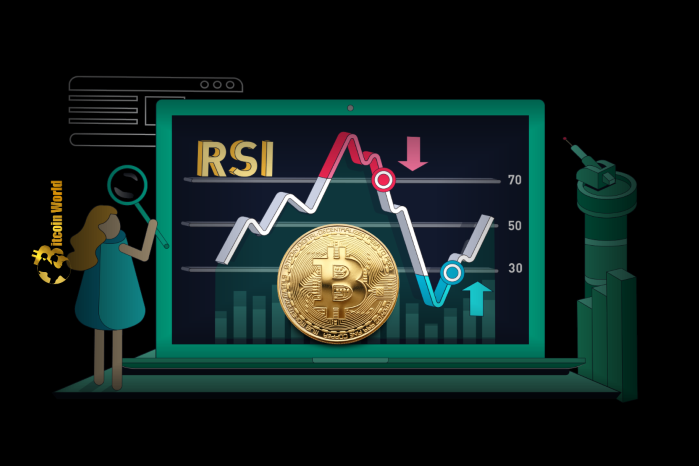Crptocurrency
Matrixport: Bitcoin’s RSI Signals Neutrality Ahead of U.S. Election

Matrixport: Bitcoin’s RSI Signals Neutrality Ahead of U.S. Election
As the U.S. presidential election approaches, Bitcoin (BTC) traders are closely monitoring key technical indicators to gauge market sentiment and potential price movements. In a recent post on X (formerly Twitter), Matrixport reported that Bitcoin’s 21-day Relative Strength Index (RSI) has dropped to 56%, well below the overbought threshold of 70%. This neutral RSI suggests a balanced market, indicating that Bitcoin may be poised for stability rather than significant upward or downward movements as the election nears.
Understanding the Relative Strength Index (RSI)
What is RSI?
The Relative Strength Index (RSI) is a momentum oscillator developed by J. Welles Wilder Jr. that measures the speed and change of price movements. RSI values range from 0 to 100, with values above 70% typically indicating that an asset is overbought (potentially overvalued and due for a price correction), and values below 30% suggesting that an asset is oversold (potentially undervalued and due for a price rebound).
Significance of RSI in Cryptocurrency Trading
In the highly volatile cryptocurrency market, RSI serves as a crucial tool for traders to identify potential reversal points, gauge market sentiment, and make informed trading decisions. A neutral RSI, such as Bitcoin’s current 56%, indicates that the asset is neither overbought nor oversold, suggesting a period of consolidation or balanced trading sentiment.
Current RSI Analysis: Bitcoin at 56%
Balanced Market Sentiment
Matrixport’s observation of Bitcoin’s RSI dropping to 56% highlights a balanced market where neither buyers nor sellers dominate. This neutrality suggests that Bitcoin’s price movements are steady, with no immediate indications of a significant rally or decline. Traders may interpret this as a period of consolidation, where the market digests recent price movements and prepares for potential future trends.
Decreased Risk Premium and Volatility
A neutral RSI implies that Bitcoin’s risk premium—the return above the risk-free rate investors expect for taking on additional risk—is likely to decrease post-election. With fewer traders caught in extreme market conditions, implied volatility, which measures the market’s expectation of future price fluctuations, may also decline. This reduced volatility can lead to a more predictable trading environment, making it easier for investors to plan their strategies.
Historical Context: Comparing Past RSI Levels
March’s RSI of 80%
In March, Bitcoin’s RSI reached an overbought level of 80%, a critical indicator that often precedes a significant price downturn. Following this peak, Bitcoin experienced a notable price correction, aligning with Matrixport’s analysis that extreme RSI levels can signal impending market reversals.
Sharp Rallies in July and August with RSI at 25%
Conversely, in July and August, Bitcoin’s RSI plunged to 25%, indicating an oversold condition. This low RSI level typically precedes a price rebound or a strong rally, as the asset becomes attractive to buyers seeking to capitalize on perceived undervaluation. These rallies underscore the RSI’s effectiveness in predicting market movements based on momentum.
Implications for Bitcoin Traders and Investors
Strategic Positioning Ahead of the Election
With the RSI signaling neutrality, Bitcoin traders might adopt strategies that balance risk and reward, such as:
- Range Trading: Capitalizing on price movements within a defined range, buying near support levels and selling near resistance.
- Breakout Strategies: Preparing for potential breakout moves if Bitcoin’s price breaks above resistance or below support, triggering significant price swings.
- Hedging: Utilizing options and futures contracts to protect against unexpected price movements.
Monitoring Key Support and Resistance Levels
Traders should closely monitor key support and resistance levels, as these can provide valuable insights into potential price movements. A break above resistance might signal a bullish trend, while a break below support could indicate bearish momentum.
Diversification and Risk Management
Given the inherent volatility of cryptocurrencies, diversification across different assets and robust risk management practices are essential. Investors may consider spreading their investments to mitigate potential losses from sudden market downturns.
Expert Insights
Dr. Emily Carter, Blockchain Analyst
“Bitcoin’s current RSI of 56% suggests a period of equilibrium in the market. This balanced sentiment is a healthy sign, indicating that neither bulls nor bears are in control. As the election approaches, we can expect traders to remain cautious, awaiting clear signals before making significant moves.”
Mark Thompson, Financial Strategist
“The neutral RSI reflects a market in a holding pattern, absorbing recent price fluctuations. Traders should be prepared for heightened volatility post-election, but the current state allows for strategic positioning without the immediate pressure of extreme market conditions.”
Sarah Lee, Cryptocurrency Researcher
“Bitcoin’s RSI at 56% is an encouraging indicator for long-term investors. It suggests stability, which can attract more institutional interest. However, the upcoming election will undoubtedly introduce new variables, and traders should stay informed about both political and market developments to navigate the potential volatility effectively.”
Future Outlook: Post-Election Bitcoin Dynamics
Potential Scenarios Based on Election Outcomes
- Bullish Scenario: If the election results in policies that favor cryptocurrency adoption and innovation, Bitcoin could experience a price rally, moving towards the upper end of the projected volatility range.
- Bearish Scenario: Conversely, if the election leads to stricter regulations or unfavorable economic conditions, Bitcoin may face downward pressure, testing lower support levels.
- Neutral Scenario: A closely contested election with mixed policy outcomes could result in a period of consolidation, with Bitcoin’s price remaining stable within a defined range.
Impact of Federal Reserve Decisions
Beyond the election, the Federal Reserve’s decisions on interest rates and monetary policy will play a crucial role in shaping Bitcoin’s market dynamics. Easing monetary policies could inject liquidity into the market, potentially supporting Bitcoin’s price, while tightening measures may contribute to bearish trends.
Technological and Adoption Factors
Continued advancements in Bitcoin’s technology, such as scalability improvements and enhanced security measures, will bolster its utility and adoption. Increased integration with traditional financial systems and growing institutional investment can further stabilize and elevate Bitcoin’s market position.
Conclusion
Matrixport’s report of Bitcoin’s RSI at 56% highlights a neutral market sentiment as the U.S. presidential election approaches. This balanced RSI level indicates a period of consolidation, with traders preparing for potential volatility driven by political and economic factors. Historical comparisons to past RSI levels underscore the importance of technical indicators in predicting market movements, while expert insights emphasize the need for strategic positioning and robust risk management.
As Bitcoin navigates through this period of equilibrium, the forthcoming election results and Federal Reserve decisions will be pivotal in determining its future trajectory. Investors and traders should remain vigilant, leveraging technical analysis and staying informed about broader market and regulatory developments to effectively navigate the evolving cryptocurrency landscape.
To stay updated on the latest developments in cryptocurrency markets and investment strategies, explore our article on latest news, where we cover significant events and their impact on the digital asset ecosystem.
Disclaimer: The information provided is not trading advice, Bitcoinworld.co.in holds no liability for any investments made based on the information provided on this page. We strongly recommend independent research and/or consultation with a qualified professional before making any investment decisions.
Crptocurrency
BTC/Gold Index Sees Biggest Single-Day Surge Since 2022 Following Trump’s Election Win

Crptocurrency
Rekt Raises $1.5M Seed Round Backed by Angels and Community, Following Sell-Out Success of Rekt Drinks

Crptocurrency
JP Morgan Analysts Expect Bitcoin and Gold Gains Under Trump Presidency

JP Morgan Analysts Expect Bitcoin and Gold Gains Under Trump Presidency
JP Morgan analysts, led by Nikolaos Panigirtzoglou, foresee a strong bullish outlook for gold and Bitcoin under President-elect Donald Trump’s administration, driven by what they term a “debasement trade” strategy. This approach aims to profit from anticipated currency devaluation and inflationary pressures, which typically benefit assets viewed as stable stores of value, including gold and Bitcoin. JP Morgan’s analysis suggests that continued demand for exchange-traded funds (ETFs), geopolitical uncertainties, and major Bitcoin acquisitions by companies like MicroStrategy will support this trend through 2025.
Key Drivers Behind JP Morgan’s Bullish Prediction
Several factors underpin JP Morgan’s expectation of gains for Bitcoin and gold in the upcoming years:
- Debasement Trade Strategy: The “debasement trade” benefits from policies that lead to currency devaluation, particularly during periods of expansionary fiscal policies. As the U.S. dollar loses value, investors often turn to hard assets like gold and Bitcoin to preserve purchasing power, positioning them as attractive hedges.
- Geopolitical Tensions and Trade Policies: Trump’s stance on trade tariffs and the possibility of increased geopolitical tensions could lead to further dollar devaluation, adding to the appeal of Bitcoin and gold as alternative assets.
- Rising Demand for Gold and Bitcoin ETFs: The analysts note significant demand for Bitcoin and gold ETFs since mid-2023, driven largely by retail investors. As institutional interest grows, these ETFs provide an accessible means of exposure, bringing fresh capital to both assets.
- MicroStrategy’s Bitcoin Acquisition Plans: MicroStrategy, a major corporate holder of Bitcoin, has announced plans to increase its holdings. This institutional investment, combined with favorable economic conditions, is expected to create upward pressure on Bitcoin’s price, signaling confidence among large-scale investors.
The Role of Gold and Bitcoin as Inflation Hedges
Both gold and Bitcoin are widely recognized as stores of value that can serve as inflation hedges. In periods of high inflation or economic uncertainty, investors tend to favor assets that are not directly tied to fiat currencies, making gold and Bitcoin particularly attractive. Here’s how each asset fulfills this role:
- Gold: Historically, gold has been a go-to asset during periods of inflation and currency devaluation. Its tangible, finite supply makes it a safe haven in times of economic instability, offering stability when other assets might be declining in value.
- Bitcoin: While relatively new, Bitcoin’s limited supply of 21 million coins positions it as a “digital gold” with deflationary characteristics. Investors increasingly view Bitcoin as an inflation hedge, especially as regulatory clarity and institutional interest grow.
How Trump’s Economic Policies Could Boost Gold and Bitcoin
Under Trump’s administration, certain economic policies could amplify demand for Bitcoin and gold. Here’s what JP Morgan analysts highlight as key areas of influence:
- Expansionary Fiscal Policies: Trump’s prior administration implemented tax cuts and expansionary measures that drove economic growth but also increased federal debt. If similar policies are enacted, they could result in inflationary pressures, driving up demand for assets like gold and Bitcoin as stores of value.
- Increased Tariffs and Geopolitical Uncertainty: Trade policies, particularly tariffs, can lead to currency instability. Bitcoin and gold could benefit as investors seek out assets with less exposure to fiat currency fluctuations and trade uncertainties.
- Support for Financial Innovation: Trump has previously expressed interest in fostering innovation within the financial sector, which may include support for cryptocurrency regulation. A regulatory environment that favors digital assets could encourage institutional investment, further supporting Bitcoin’s price growth.
Growing ETF Demand Signals Institutional Interest
The report also highlights the impact of ETF demand on Bitcoin and gold prices. The introduction of ETFs for both assets has allowed a broader range of investors to participate in these markets, bringing liquidity and stability. Key points include:
- Retail Investor Demand: Since mid-2023, retail interest in ETFs has surged, particularly for Bitcoin ETFs. These products provide convenient and regulated access to Bitcoin, fueling demand and adding stability to its market.
- Institutional Adoption of Bitcoin ETFs: With major players like BlackRock and Fidelity entering the Bitcoin ETF market, institutional adoption is likely to increase, encouraging further investments. ETFs lower the entry barrier for large investors and hedge funds, contributing to Bitcoin’s mainstream acceptance.
MicroStrategy’s Bitcoin Strategy and Institutional Confidence
MicroStrategy has been one of the most vocal institutional supporters of Bitcoin, holding significant amounts of BTC on its balance sheet. The company’s plans for continued Bitcoin acquisitions reflect a broader trend of institutional confidence in Bitcoin as an asset class:
- Corporate Bitcoin Holdings: By increasing its Bitcoin reserves, MicroStrategy is signaling confidence in Bitcoin’s long-term value, potentially inspiring other companies to follow suit. This institutional buy-in could stabilize Bitcoin’s price and encourage broader adoption.
- Market Influence: MicroStrategy’s Bitcoin holdings influence market sentiment, as its public commitment to Bitcoin boosts investor confidence and supports a long-term bullish outlook.
Risks to JP Morgan’s Prediction
While JP Morgan’s outlook is optimistic, analysts have identified potential risks that could impact Bitcoin and gold’s performance:
- Regulatory Changes: Shifts in U.S. regulatory policy, particularly around digital assets, could introduce volatility to Bitcoin’s price. Strict regulations could dampen institutional participation and ETF demand, slowing Bitcoin’s growth.
- Economic Policy Reversals: If Trump’s administration implements policies that strengthen the dollar, such as reducing tariffs or prioritizing economic stability, the demand for Bitcoin and gold as inflation hedges may decrease.
- Market Volatility: Bitcoin’s inherent volatility remains a consideration for investors. Market corrections could impact short-term performance, even with strong long-term fundamentals.
Conclusion
JP Morgan’s analysis underscores a favorable outlook for Bitcoin and gold under Trump’s presidency, with expectations that inflationary policies, rising ETF demand, and strategic acquisitions by firms like MicroStrategy will drive these assets’ growth. The “debasement trade” strategy, geared toward profiting from currency devaluation, supports this trend by encouraging investment in assets seen as stores of value during economic uncertainty.
If these factors align, Bitcoin and gold could experience significant gains in the coming years, with Bitcoin’s expanding role as a digital store of value potentially setting new price benchmarks. For investors, this forecast highlights the strategic value of these assets within a diversified portfolio, particularly as the economy navigates potential inflation and currency pressures.
For further insights on Bitcoin, gold, and inflationary trends, explore our latest market analysis on investment strategies and asset performance under shifting economic policies.
Disclaimer: The information provided is not trading advice, Bitcoinworld.co.in holds no liability for any investments made based on the information provided on this page. We strongly recommend independent research and/or consultation with a qualified professional before making any investment decisions.
-

 Startup Stories1 year ago
Startup Stories1 year agoWhy Millennials, GenZs Are Riding The Investment Tech Wave In India
-

 Startup Stories1 year ago
Startup Stories1 year agoStartups That Caught Our Eyes In September 2023
-

 Startup Stories1 year ago
Startup Stories1 year agoHow Raaho Is Using Tech To Transform India’s Fragmented Commercial Trucking
-

 Startup Stories12 months ago
Startup Stories12 months agoMeet The 10 Indian Startup Gems In The Indian Jewellery Industry’s Crown
-

 Crptocurrency8 months ago
Crptocurrency8 months agoLither is Making Crypto Safe, Fun, and Profitable for Everyone!
-

 Startup Stories1 year ago
Startup Stories1 year agoHow Volt Money Is Unlocking The Value Of Mutual Funds With Secured Lending
-

 Startup Stories1 year ago
Startup Stories1 year agoWhy Moscow-Based Kladana Considers Indian SME Sector As The Next Big Market For Cloud Computing
-

 E-commerce1 year ago
E-commerce1 year agoTop Online Couponing Trends To Watch Out For In 2016




